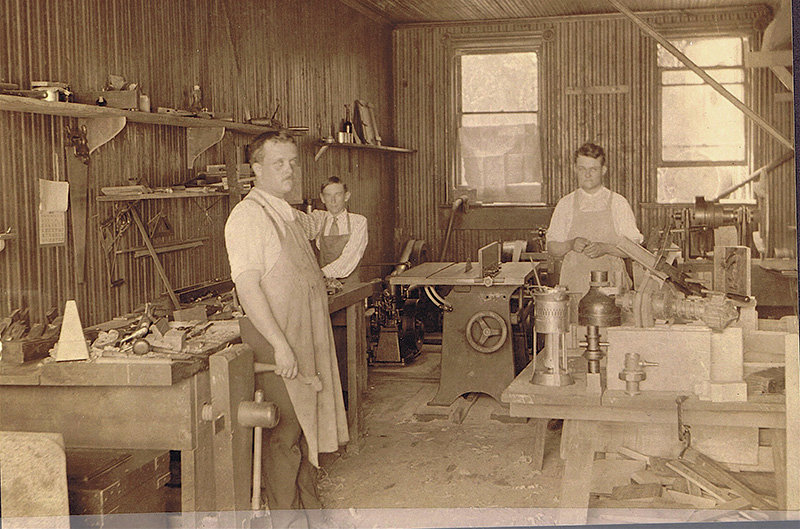
The Gardiner brothers and son in their woodworking shop in 1907.
By Mary McTamaney
There seems to be an added sound to be heard this Spring around the streets of Newburgh. In addition to the delicate chirping of birds, there is the louder screeching of power saws cutting through wood. Trucks and vans and dumpsters are parked at the curbs and people busily empty and refill them as they crisscross into houses under reconstruction.
The south end of William Street, once written off as near death, is coming back as Habitat for Humanity of Greater Newburgh transforms seven old row houses into single-family homes again. I drove over to watch this month and was amazed to see that the block of brick houses on the west side of William had cast iron windowsills. Exploring, I found that a handful of houses around the corner on Renwick Street did too. What builder, we can wonder, added that feature and where did he order such decorative windowsills? They were certainly used in Victorian buildings in the second half of the 19th century but rarely in such modest houses as the little ones on William Street. Newburgh did have several foundries but, if cast iron windowsills were a local product, we would expect to see more of them. They are just one of the interesting little decorative touches to be found in the hundreds of old houses in a city of Newburgh’s age.
A century ago, the sounds of saws and hammers would have been louder than today all around this city. The turn of the 20th century was one of significant expansion as industries grew and took on more workers. Houses rose on lots that had been long empty or had been used for gardens and barns. To complete those houses, every type of trim and fixture was sought and scores of small craftsmen produced those parts. There were no “big box” home improvement stores in 1900. Instead, Newburgh contractors depended on the large and small workshops inside the city limits. Newburgh Planing Mill was one of the biggest production facilities making stairs and railings and every kind of woodwork. To this day, houses in so many neighborhoods share a trim style that their builders selected from a local shop like Newburgh Planing Mill. That is why most of my block of World War I era homes have the same newel posts, stair spindles, baseboards and crown moldings.
Lots of small shops provided trim and custom cabinetry as well. Built-in bookcases and sideboards, doors for cupboards tucked under a stairway, bathroom shelves and cabinets to hold kitchen necessities were all crafted to suit the homeowners who craved efficient and attractive storage.
Down the hill from the same neighborhood where Habitat is busily working, three members of the Gardiner family operated a small woodworking business at 136 Renwick Street. The picture here was shared by one of their descendents now living in Arizona. It shows Charles H. Gardiner in the foreground and his son, Charles H., Junior at a workbench that appears to have drill press. To the right is Robert S. Gardiner, Charles’ brother. All wear heavy aprons and the shop is outfitted with so many of the tools that I recall my grandfather using now and then. Since old city directories list the Gardiner family as living and working at the Renwick Street address, it is very possible that the driveway and even the garage at the back of 136 Renwick Street today could be the Gardiner’s old workshop. How many sounds and sights of past craftsmen can we imagine as we walk around Newburgh, especially the south side neighborhoods of Washington Heights where the city grew so quickly as the last century turned?